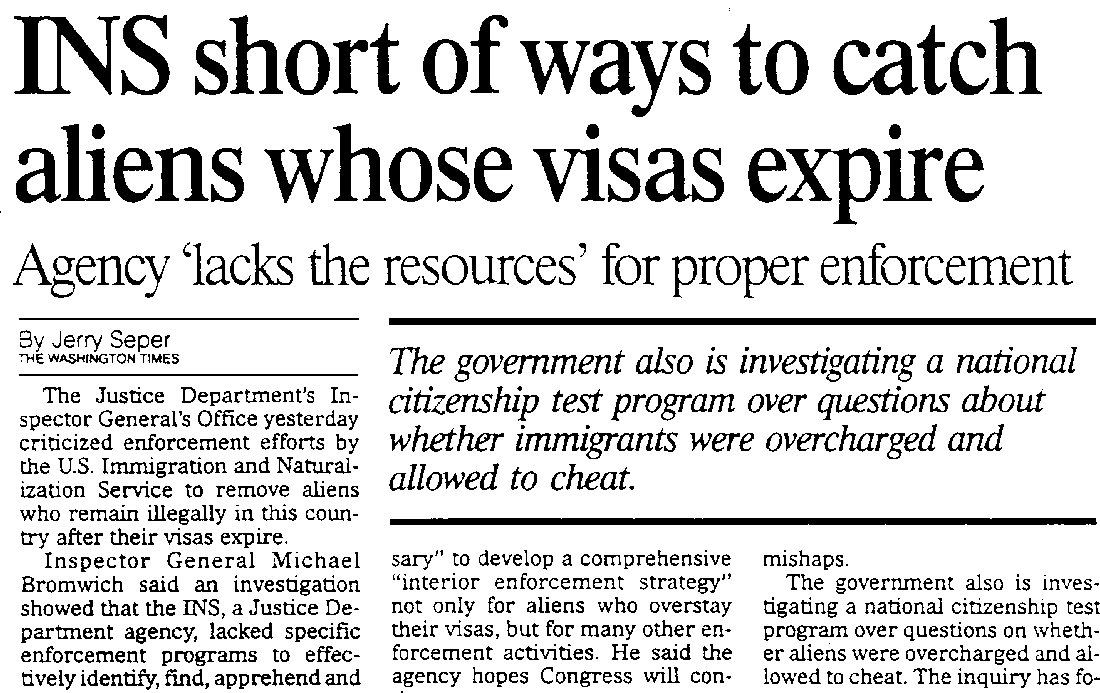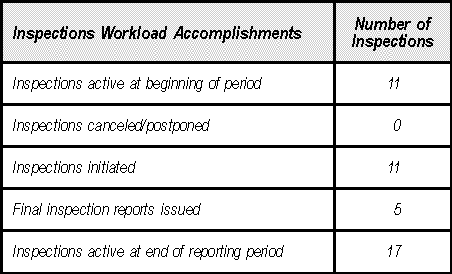The Washington Times Friday, September 5, 1997

USDOJ/OIG - Semiannual Report to Congress, April 1, 1997 - September 30, 1997 |
Page 26 |
The Inspections DivisionThe Inspections Division assesses Department programs and activities and makes recommendations to decisionmakers for improvements in Department programs, policies, and procedures. |
USDOJ/OIG - Semiannual Report to Congress, April 1, 1997 - September 30, 1997 |
Page 27 |
Inspections Division
The Inspections Division (Division) provides the Inspector General with an alternative mechanism to traditional audit and investigative techniques to assess Department of Justice (Department) programs and activities. The Division conducts analyses and makes recommendations to decisionmakers for improvements in Department programs, policies, and procedures. The Division's strength lies in its multidisciplinary workforce and the ability to quickly address diverse issue areas. In addition to assessing Department programs, the Division also conducts special reviews—assignments requiring immediate action—that are generally initiated at the request of senior Department management or by Congress.
During this reporting period, the Division conducted a critical analysis of the
Immigration and Naturalization Service's (INS) enforcement efforts to remove aliens who
remain illegally in this country after their visas expire, assessed the extent of the VISA
purchase card use and identification of barriers to increased card use by Department
employees, and worked with the Office of Justice Programs (OJP) in its implementation of
the Violent Offender Incarceration and Truth-In-Sentencing Incentive Grant Program.
INS' Monitoring of Nonimmigrant Overstays
In our continuing effort to address illegal immigration issues, we conducted an assessment of INS' monitoring of nonimmigrant overstays. The review was based on nonimmigrant information and enforcement activities for Fiscal Years (FYs) 1992 through 1996.
Our inspection found that INS does not have a specific overstay enforcement program to effectively identify, locate, apprehend, and remove overstays. Although the overstay population is estimated to be about 2 million, with annual increases of 125,000, only about 10,000 overstays were apprehended and about 5,000 deported in FY 1996. We also found that INS' primary information system on nonimmigrants—Non-immigrant Information System (NIIS)—was not producing reliable individual or aggregate overstay data and that it had not produced reliable data on the number of overstays by country of origin since FY 1992. By design, NIIS captures information on only about 10 percent of nonimmigrant entries into the United States. Further, the data on nonimmigrants tracked in NIIS is incomplete and unreliable.
The Washington Times Friday, September 5, 1997

Based on these findings, we determined that INS is unable to meet its statutory responsibilities under the Visa Waiver Pilot Program (VWPP). The VWPP permits persons from designated countries to enter the United States without obtaining a visa. In FY 1995, over 10 million nonimmigrants entered the
USDOJ/OIG - Semiannual Report to Congress, April 1, 1997 - September 30, 1997 |
Page 28 |
Significant Inspections
United States under this program. By law, a country must maintain a low overstay rate to remain in the VWPP. Because INS' overstay estimates are too unreliable to be used as evidence, INS has stopped disqualification procedures based on high overstay rates.
To address report weaknesses, we recommended that INS correct deficiencies in NIIS and develop an interior enforcement strategy that effectively addresses the growing overstay population.
Use of the VISA Purchase Card in the Department
Since 1989, the Department has participated in the General Services Administration's Governmentwide Commercial Credit Card Services Program. Use of the VISA purchase card provides a more efficient and less costly method of procurement than traditional methods such as purchase orders. At the request of the Assistant Attorney General for Administration (AAG/A), we reviewed the Department's VISA purchase card program to determine the extent of VISA card use, identify barriers to increased use, and assess the program's internal controls.
Our inspection found that most Department components have designated cardholders in their field and program offices and have increased their use of the VISA cards. Despite increased use, the Department used the VISA card for less than 10 percent of its total micropurchases (purchases under $2,500) in FY 1995 and 31 percent in FY 1996. Further, we noted that none of the components takes full advantage of the refund available from the VISA card contractor.
Our inspection also identified two barriers to increased VISA card distribution and use: a preference in some components for alternative procurement and payment methods and the fear that employees would not use the cards appropriately. However, our review of a sample of cardholders' transactions indicates that, overall, Department cardholders use VISA cards responsibly and that misuse is not a significant problem. The internal controls contained in the VISA card program and the components' administrative procedures, overall, are sufficient to prevent and detect misuse.
We recommended that:
· OJP, U.S. Marshals Service (USMS), and Executive Office for U.S. Attorneys (EOUSA) complete implementation of the VISA purchase card program by distributing cards to program and field offices that do not have them or notify the AAG/A why this is not feasible.
· The AAG/A follow up on actions taken by USMS, OJP, and EOUSA to complete VISA program implementation and advise us when card distribution is complete.
· The Department mandate VISA card use for micropurchases, when possible.
We also suggested that the Department encourage components to seek the full refund offered by the VISA card contractor.
USDOJ/OIG - Semiannual Report to Congress, April 1, 1997 - September 30, 1997 |
Page 29 |
Significant Inspections
Oversight of Background Investigations by SEPS
As part of the OIG's follow-up process, inspectors assessed procedures used by the Justice Management Division's Security and Emergency Planning Staff (SEPS) to oversee background investigations (BIs) for Department employees. For the follow-up review, we selected EOUSA and reviewed information gathered from EOUSA and U.S. Attorneys' Offices (USAOs) to test the status of SEPS' oversight of BIs, reinvestigations (RIs), and National Security Information clearances.
Our inspection concluded that SEPS is not closely monitoring how EOUSA administers RIs for its employees to ensure that the highest priority employees receive RIs. In addition, we are concerned that EOUSA is not allocating resources to the USAOs in a manner that ensures the highest priority employees receive RIs. We found that 1,199, or 49 percent, of the 2,445 EOUSA employees due for an RI in FY 1995 had last received clearances seven or more years earlier. Also, 53 of the 1,199 employees with overdue RIs possessed security clearances and, therefore, should have received priority in getting their RIs.
We also found that SEPS is adjudicating BIs and RIs within a reasonable period of time and that new employees received waivers prior to entering on duty. SEPS is also finalizing an automated system called "TRAQ" that will allow it to monitor BIs and RIs effectively and to resolve problems with missing files and data discrepancies.
We recommended that SEPS increase its monitoring to ensure that RIs are initiated, completed, and adjudicated for the highest priority employees and in conformance with the annual guidelines for assigning priorities to RIs. We also recommended that EOUSA allocate RI resources among the USAOs in a manner that ensures the highest priority employees receive RIs.
VOI/TIS Grant Program Reviews
Through the Violent Offender Incarceration and Truth-in-Sentencing (VOI/TIS) Incentive Grant Program, created under the Violent Crime Control Act of 1994, funding is awarded to eligible states as formula grants to build or expand correctional facilities to increase secure confinement space for violent offenders and for implementing Truth-in-Sentencing statutes. Inspectors conduct site reviews of VOI/TIS grant recipients to ensure that the grantee is achieving program objectives and the federal funds are spent in accordance with program requirements. During this period, we completed reviews for the states of North Carolina and Iowa. Comments, suggestions, and recommendations contained in these reports will be used by OJP to improve and enhance the management of the VOI/TIS program.
USDOJ/OIG - Semiannual Report to Congress, April 1, 1997 - September 30, 1997 |
Page 30 |
The below chart summarizes the Inspections Division's workload accomplishments for the
6-month reporting period ending September 30, 1997.
